“The relationship we share with Yamuna is that of a mother and son. In the last 30 years, I have seen the river change in front of my eyes. It is sad to see what it has become now,” says Randheer, a floodplain farmer who lives along the Yamuna Khadar near Delhi’s Raj Ghat. Just 15 kilometres away, 70-year-old Kalicharan, who resides along the banks of the river near Mayur Vihar, adds, “Earlier, we used to drink its water and take a bath. Now we can’t even go next to it because of how dirty it is.”
Randheer and Kalicharan are among the many residents of Delhi who have been directly affected by the depleting water quality of the Yamuna for over three decades now.
Yamuna — Then and Now
The Yamuna River, a major tributary of the Ganges, originates from the Yamunotri glacier in western Garhwal in Uttarakhand. Colloquially called Jamuna, the river has been a witness to the numerous civilizations and cities that came into existence, thrived, and faded away along its banks. The Yamuna has a longstanding history with the city of Delhi. Not only is it historically and culturally significant to the national capital, but the river is also central to the city’s visual imagination.
Its water is used for farming and irrigation, making it one of the highest food-yielding river basins in the country benefiting Haryana, Uttar Pradesh, NCT of Delhi, Rajasthan, and Uttarakhand.
It is also the main source of raw water for the national capital and is a breeding ground for aquatic organisms. The farming and fishing communities have lived along the banks of the river for generations now.
Suresh Kumar, once a floodplain farmer, reminisces about his childhood days spent near the Yamuna. “When we were young, we used to interact with the river daily. The water used to be so clean that we used to not just take a bath but also drink it without filtering it”.
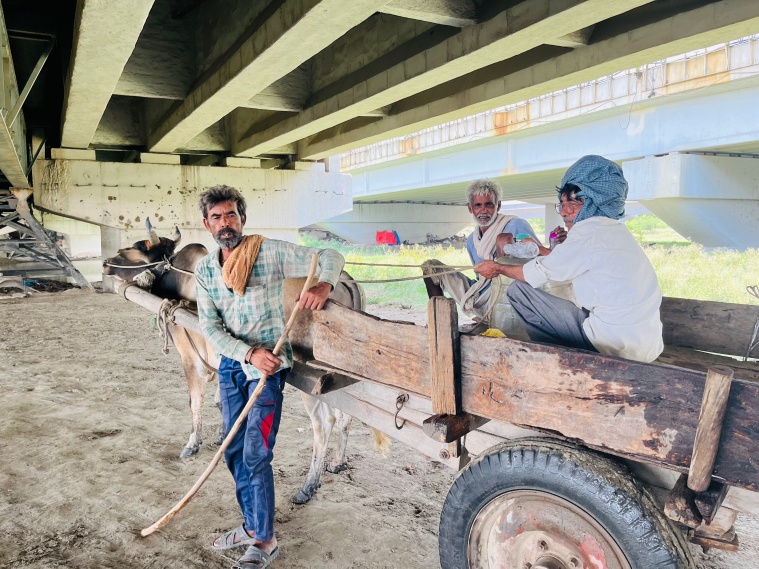 The farming and fishing communities have lived along the banks of the Yamuna river for generations now. (Express/Varsha Sriram)
The farming and fishing communities have lived along the banks of the Yamuna river for generations now. (Express/Varsha Sriram)
Kalicharan recalls the time when the floodplains would be lined up with lush green fields and he would cultivate fresh vegetables including tomatoes, radishes, cauliflower, and carrots. “The quality of the vegetables was extremely good and we used to make a livelihood by selling them.”
Meanwhile, Ratan Kumar, once a fisherman near the Wazirabad barrage of Yamuna, talks about the thriving marine life in the river 20 years ago.
“Back then, we used to be able to catch around 6-7 types of fish, including Rong Lai, Catla, Siren, Bachua, Mushi, and Mori. On average, we used to catch around 50 kgs and sell them in the market,” he says, adding that they now barely manage to catch about five kgs of fish every day.
“This is not enough to make money,” he says. Ratan left fishing to become a driver.
Not just farming and fishing, the Yamuna has also been a recreational and religious spot. Locals recall how the river has been an integral part of their lives.
“Back in the 90s, people used to visit the river often and interact with it in many ways,” says Randheer, adding that it was a picnic spot for many.
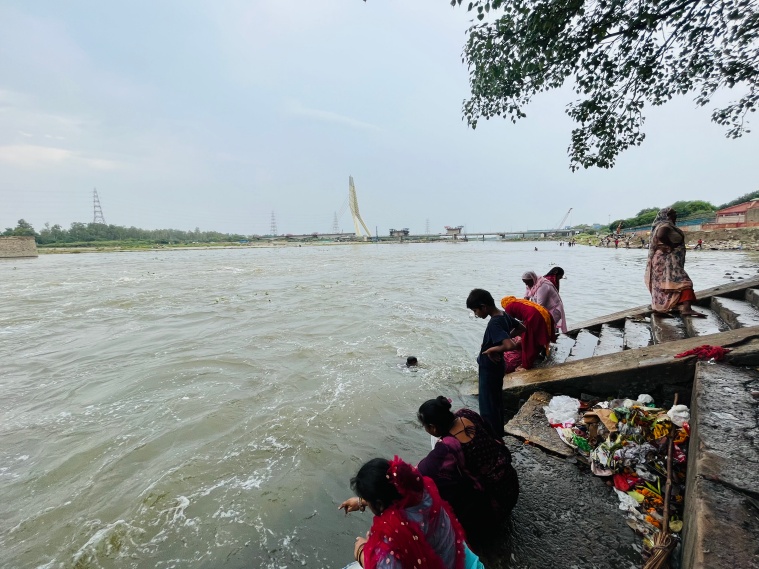 The Yamuna has been a religious spot for many. Locals recall how the river has been an integral part of their lives. (Express/Varsha Sriram)
The Yamuna has been a religious spot for many. Locals recall how the river has been an integral part of their lives. (Express/Varsha Sriram)
Bagvathi, who resides in a temporary hut on the floodplains near Mayur Vihar, narrates stories of how women from their community would come together during festival days and perform pujas next to the river. “Every year, we celebrate Chhath Puja near the banks of the river. We get into the river and do the puja as it’s our tradition,” she says.
Kalicharan adds that during Purnima and Amavasya, people used to take a dip in the river in the evenings. Purnima or a full moon day, and Amavasya, also known as the new moon day, is considered of great religious significance in Hinduism.
A ‘dead river’
On July 2, 1979, the Indian Express published a report which said, “The Yamuna is fated to be an open sewer sooner or later. And this catastrophe may befall us in 30 years’ time, according to environmental engineers who have been watching the fast-changing water quality profile of the river”.
Today, Yamuna is one of the most polluted rivers in the country. Sewage and domestic and industrial effluents have made its water toxic and unfit for consumption. Studies have called it a “glorified drain” and a “dead river”, unable to sustain any life.
The clear blue waters in which, as Randheer recalls, one would be able to see a coin if they dropped it inside, is now covered with toxic foam.
According to a 2020 report by the now-dissolved Yamuna Monitoring Committee (YMC), which was set up by the National Green Tribunal to oversee cleaning efforts, the 22-kilometre stretch of the Yamuna which traverses Delhi is only two per cent of the length of the river but accounts for over 75 per cent of the total pollution load in the river, which comes from untreated domestic sewage, industrial and solid waste.
In her research paper What the Eye Does Not See: The Yamuna in the Imagination of Delhi, Amit Baviskar, sociologist and professor of Environmental Studies and Sociology and Anthropology at Ashoka University, talks about the visible shift of the Yamuna in the social and ecological imagination of Delhi. She explains how the riverbed has changed from being a neglected “non-place” to prized real estate for private and public corporations.
Baviskar argues that “the transformation of an urban commons into a commodity is not only embedded in processes of political economy but is also driven by aesthetic sensibilities that shape how ecological landscapes are valued.”
At the Hathni Kund barrage in Haryana, the Western Yamuna Canal and Eastern Yamuna Canal divert the river waters to Haryana and Uttar Pradesh, respectively. The remaining water reaches the Wazirabad barrage.
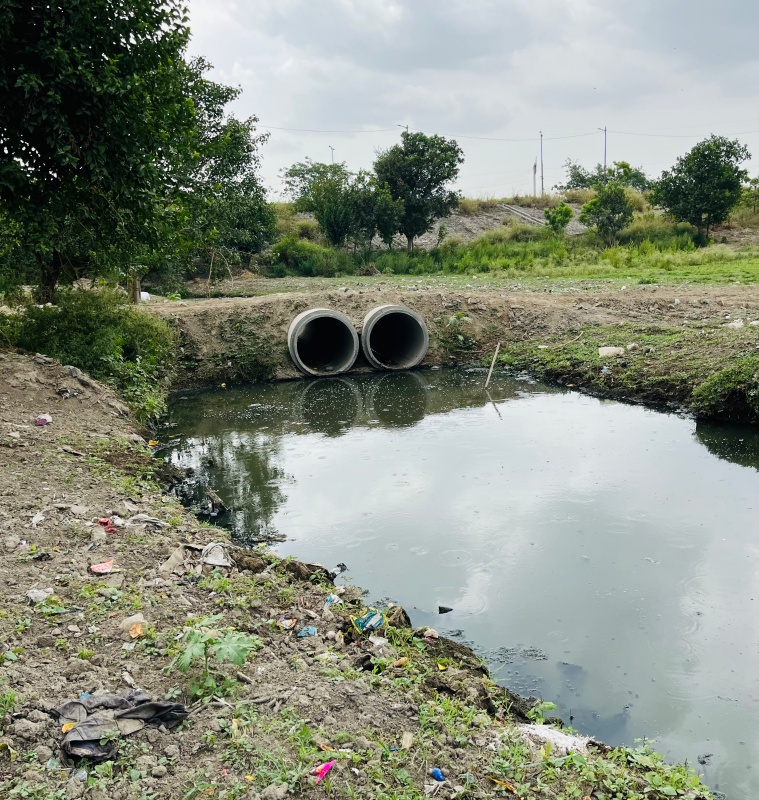 The 22-kilometre stretch of the Yamuna in Delhi is only two per cent of the length of the river but accounts for over 75 per cent of the total pollution load in the river. (Express/Varsha Sriram)
The 22-kilometre stretch of the Yamuna in Delhi is only two per cent of the length of the river but accounts for over 75 per cent of the total pollution load in the river. (Express/Varsha Sriram)
Speaking to indianexpress.com, Meeta Kumar, Associate Professor, Miranda House, says there are two main problems with the Yamuna water in Delhi — the solid waste and sewage is being dumped into the river, and the water flowing through the Yamuna dries out by the time it reaches Delhi.
“If you imagine the Yamuna as a channel of water that’s flowing, you tend to not see the other parts that are actually part of the river system, such as the floodplains. If you treat them as different from the river, it’s almost as if the river is encroaching on land in your imagination,” she says.
As the river heads downstream, all that’s left are the domestic and industrial effluents, except during monsoon season when excess water is released at Hathnikund and Wazirabad.
Bhim Singh Rawat, a water activist, says that over time the amount of fresh flowing water in the river has drastically reduced due to the supply of water to the Hathni Kund barrage, and west and east canals for industrial purposes.
Despite various rejuvenation plans and multiple orders by courts and government bodies, the exploitation of the Yamuna continues.
Traversing about 52 kilometres in NCT Delhi, there are three stretches to the river — Northern stretch, running over 26 kilometres from the Palla village to Wazirabad barrage, ‘Central stretch’, running over 22 km from the Wazirabad barrage till the Okhla Barrage, and ‘Southern stretch’, running over four kilometres from the Okhla barrage till Jaitpur Village.
In an article in India Water Portal, a national knowledge platform and repository for water and related issues, late environmentalist Anupam Misra wrote about why Yamuna is “Delhi’s real town planner”.
“One major river, its 18 tributaries, and some 800 big or small tanks and lakes dotted Delhi from one end to the other. Add to this layout of the city a few thousand wells and bavdhis (stepwell). This design ensured Delhi was never short of water, never had a famine, and was never ravaged by floods,” he said, adding, “Delhi was once well-planned along the course of the river Yamuna but it isn’t so any more”.
Contrary to popular perception, not the entire 22-kilometre-long stretch of the Yamuna which falls within the administrative boundaries of Delhi is polluted. The northern stretches of the river, lying in the Wazirabad-Jagatpur area, have been able to skip much of the ecological damages compared to other areas.
However, when we visited the Wazirabad barrage area, below the Signature Bridge in North Delhi, we saw people throwing waste into the river.
30-year-old Rohit, a professional diver says, “In a day, I am in the water for about 2-3 hours. I see that people throw glass items, garlands and other waste items into the river”.
Sitting by the river is Mohammad Aslam, for whom fishing is a hobby. “Don’t even ask how dirty the river has become… I’ve been coming here with my father for over 35 years now to fish and the quality and variety of the fish have reduced so much due to the effluents and sewage being thrown into the river,” he says.
 Mohammad Aslam has been fishing by the Yamuna river as a hobby for over 35 years now (Express/Varsha Sriram)
Mohammad Aslam has been fishing by the Yamuna river as a hobby for over 35 years now (Express/Varsha Sriram)
“Now, I come whenever I am free…but, it’s a chance of luck…sometimes you get to catch fish, sometimes you don’t,” he adds.
Displacement of communities along Yamuna
Apart from the fact that the river is no longer the Yamuna they grew up around, it is the eviction drive that is a major cause of concern for those living alongside the floodplains.
Successive government projects such as the Akshardham temple and the Commonwealth Games Village near the floodplains have endangered the river’s course and affected the life and livelihood of people living around it.
Since March this year, the Delhi Development Authority (DDA) has been carrying out demolition drives along the Yamuna floodplains to make way for a riverfront project.
Those affected are the people who were staying near the Yamuna Khader in Mayur Vihar — In March this year, they were asked to vacate the plains and were moved further inside under a railway track.
“We don’t have a permanent house. We have stayed along the floodplains for generations now and the DDA has been moving us from one place to another,” says Brijpal, a farmer.
His wife says they now have to fight for their survival and find odd jobs to earn a living.
Meanwhile, Mamta, who was earlier working at a school built for kids in the floodplain area says, “Ever since we moved here, we have been struggling to find food and water. It takes us an hour to reach the main road and there is no livelihood for us here.”
“After the demolition drive, our kids have not gone to school,” she adds.
Fifteen kilometres from Yamuna Khader, farmers and slum dwellers of Bela Estate Moolchand Basti near Rajghat have been demanding rehabilitation.
 Since March this year, the Delhi Development Authority (DDA) has been carrying out demolition drives along the Yamuna floodplains to make way for a riverfront project. (Express/Varsha Sriram)
Since March this year, the Delhi Development Authority (DDA) has been carrying out demolition drives along the Yamuna floodplains to make way for a riverfront project. (Express/Varsha Sriram)
“The government has begun several drives to make Yamuna a cleaner, greener river. Are you telling me those who have been farming here won’t keep the place clean? Is there someone who can do it better than us?” asks Randheer.
In March, the Delhi High Court dismissed a plea by an association of residents of Bela Estate seeking a stay on the eviction from the premises and rehabilitation by the Delhi Urban Shelter Improvement Board (DUSIB). The court observed that no documents were adduced to prove that they were part of the board’s notified jhuggi jhopri (JJ) cluster.
“We have been staying here for generations…in fact, since before the DDA was even formed. And now, they are asking us to vacate and go somewhere else,” he says.
Has Delhi turned its back on Yamuna?
A report by the Yamuna Monitoring Committee (YMC) says how over the years citizens, civic and administrative authorities have, in different ways, neglected the river. “The challenge lies in making citizens conscious of the harm they do when they pollute the river, directly or indirectly,” it says.
Rawat and Kumar say Delhi has turned its back on the river.
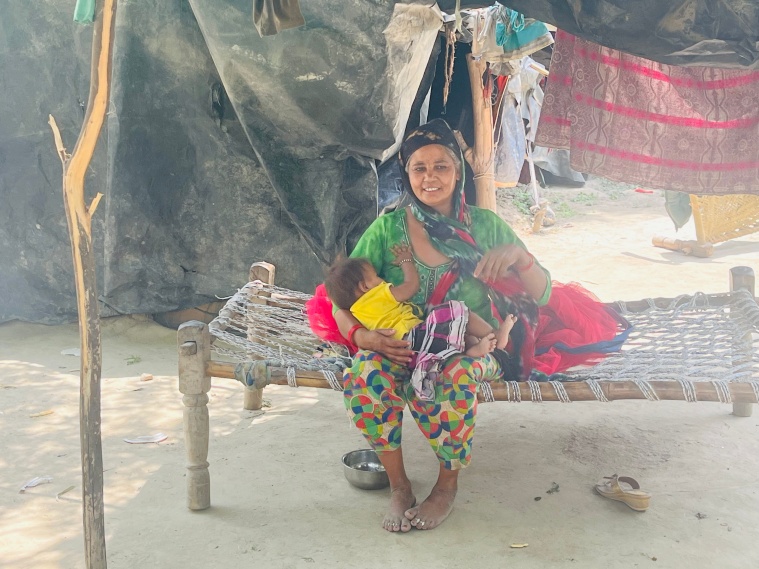 Mamta and her family are one of the affected people who were asked to vacate their houses near Yamuna Khader in Mayur Vihar — In March this year.
Mamta and her family are one of the affected people who were asked to vacate their houses near Yamuna Khader in Mayur Vihar — In March this year.
“I wonder what kind of city we are living in and what we plan to do. We live in the era of climate change where we are looking to reduce carbon footprint. Floodplain farmers have been doing organic farming and horticulture for so long and can, in many ways, contribute to the cleanliness of the river,”says Rawat.
“When you look at the Thames River, it is an active part of life in London and you can engage with the river in many ways. But can you see that with the Yamuna? That’s what I mean by turning its back on the river,” says Kumar.
“Do we have the political and cultural will to revive the river…we must get our act together, otherwise nature will retaliate. A solution will not emerge if we speak about the issue under the carpet,” she adds.
— (With Chitral Khambhati)

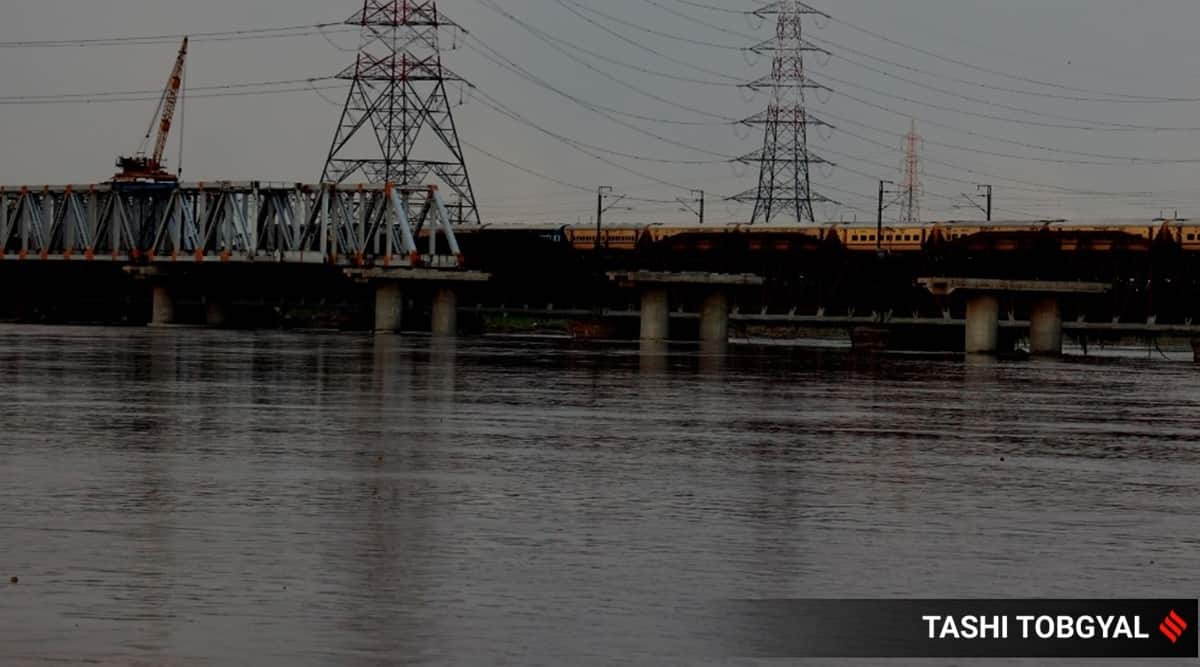


 The farming and fishing communities have lived along the banks of the Yamuna river for generations now. (Express/Varsha Sriram)
The farming and fishing communities have lived along the banks of the Yamuna river for generations now. (Express/Varsha Sriram) The Yamuna has been a religious spot for many. Locals recall how the river has been an integral part of their lives. (Express/Varsha Sriram)
The Yamuna has been a religious spot for many. Locals recall how the river has been an integral part of their lives. (Express/Varsha Sriram) The 22-kilometre stretch of the Yamuna in Delhi is only two per cent of the length of the river but accounts for over 75 per cent of the total pollution load in the river. (Express/Varsha Sriram)
The 22-kilometre stretch of the Yamuna in Delhi is only two per cent of the length of the river but accounts for over 75 per cent of the total pollution load in the river. (Express/Varsha Sriram) Mohammad Aslam has been fishing by the Yamuna river as a hobby for over 35 years now (Express/Varsha Sriram)
Mohammad Aslam has been fishing by the Yamuna river as a hobby for over 35 years now (Express/Varsha Sriram) Since March this year, the Delhi Development Authority (DDA) has been carrying out demolition drives along the Yamuna floodplains to make way for a riverfront project. (Express/Varsha Sriram)
Since March this year, the Delhi Development Authority (DDA) has been carrying out demolition drives along the Yamuna floodplains to make way for a riverfront project. (Express/Varsha Sriram) Mamta and her family are one of the affected people who were asked to vacate their houses near Yamuna Khader in Mayur Vihar — In March this year.
Mamta and her family are one of the affected people who were asked to vacate their houses near Yamuna Khader in Mayur Vihar — In March this year.